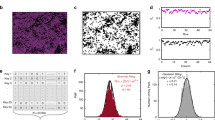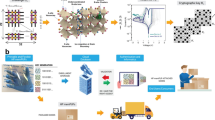Abstract
Graphene has a range of properties that makes it suitable for building devices for the Internet of Things. However, the deployment of such devices will also likely require the development of suitable graphene-based hardware security primitives. Here we report a physically unclonable function (PUF) that exploits disorders in the carrier transport of graphene field-effect transistors. The Dirac voltage, Dirac conductance and carrier mobility values of a large population of graphene field-effect transistors follow Gaussian random distributions, which allow the devices to be used as a PUF. The resulting PUF is resilient to machine learning attacks based on predictive regression models and generative adversarial neural networks. The PUF is also reconfigurable without any physical intervention and/or integration of additional hardware components due to the memristive properties of graphene. Furthermore, we show that the PUF can operate with ultralow power and is scalable, stable over time and reliable against variations in temperature and supply voltage.
This is a preview of subscription content, access via your institution
Access options
Access Nature and 54 other Nature Portfolio journals
Get Nature+, our best-value online-access subscription
$29.99 / 30 days
cancel any time
Subscribe to this journal
Receive 12 digital issues and online access to articles
$119.00 per year
only $9.92 per issue
Buy this article
- Purchase on Springer Link
- Instant access to full article PDF
Prices may be subject to local taxes which are calculated during checkout






Similar content being viewed by others
Data availability
The datasets generated during and/or analysed during the current study are available from the corresponding author upon reasonable request.
Code availability
The codes used for plotting the data are available from the corresponding author upon reasonable request.
References
Kruger, C. P. & Hancke, G. P. Benchmarking internet of things devices. In 2014 12th IEEE International Conference on Industrial Informatics (INDIN) 611–616 (IEEE, 2014).
Atzori, L., Iera, A. & Morabito, G. The internet of things: a survey. Comput. Netw. 54, 2787–2805 (2010).
Zhao, K. & Ge, L. A survey on the internet of things security. In 2013 9th International Conference on Computational Intelligence and Security (CIS) 663–667 (IEEE, 2014).
Xia, F., Yang, L. T., Wang, L. & Vinel, A. Internet of things. Int. J. Commun. Syst. 25, 1101–1102 (2012).
Suh, G. E. & Devadas, S. Physical unclonable functions for device authentication and secret key generation. In 2007 44th ACM/IEEE Design Automation Conference 9–14 (IEEE, 2007).
Pappu, R., Recht, B., Taylor, J. & Gershenfeld, N. Physical one-way functions. Science 297, 2026–2030 (2002).
Hwang, K.-M. et al. Nano-electromechanical switch based on a physical unclonable function for highly robust and stable performance in harsh environments. ACS Nano 11, 12547–12552 (2017).
Hu, Z. et al. Physically unclonable cryptographic primitives using self-assembled carbon nanotubes. Nat. Nanotechnol. 11, 559–565 (2016).
Kuribara, K. et al. Organic physically unclonable function on flexible substrate operable at 2 V for IoT/IoE security applications. Org. Electron. 51, 137–141 (2017).
Qin, Z., Shintani, M., Kuribara, K., Ogasahara, Y. & Sato, T. OCM-PUF: organic current mirror PUF with enhanced resilience to device degradation. In 2019 IEEE International Conference on Flexible and Printable Sensors and Systems (FLEPS) 1–3 (IEEE, 2019).
Rajendran, J., Rose, G. S., Karri, R. & Potkonjak, M. Nano-PPUF: a memristor-based security primitive. In 2012 IEEE Computer Society Annual Symposium on VLSI 84–87 (IEEE, 2012).
Zhang, R. et al. Nanoscale diffusive memristor crossbars as physical unclonable functions. Nanoscale 10, 2721–2726 (2018).
Chen, A. Utilizing the variability of resistive random access memory to implement reconfigurable physical unclonable functions. IEEE Electron Device Lett 36, 138–140 (2015).
Gao, L., Chen, P., Liu, R. & Yu, S. Physical unclonable function exploiting sneak paths in resistive cross-point array. IEEE Trans. Electron Devices 63, 3109–3115 (2016).
Gao, Y., Ranasinghe, D. C., Al-Sarawi, S. F., Kavehei, O. & Abbott, D. Emerging physical unclonable functions with nanotechnology. IEEE Access 4, 61–80 (2016).
Dodda, A. et al. Biological one-way functions for secure key generation. Adv. Theor. Simul. 2, 1800154 (2019).
Wali, A. et al. Biological physically unclonable function. Commun. Phys. 2, 39 (2019).
Maes, R. & Verbauwhede, I. in Towards Hardware-Intrinsic Security (eds Sadeghi, A.-R. & Naccache, D.) 3–37 (Springer, 2010).
Gassend, B., Clarke, D., Van Dijk, M. & Devadas, S. Silicon physical random functions. In Proceedings of the 9th ACM Conference on Computer and Communications Security 148–160 (ACM, 2002).
Schrijen, G.-J. & Van Der Leest, V. Comparative analysis of SRAM memories used as PUF primitives. In 2012 Design, Automation & Test in Europe Conference & Exhibition (DATE) 1319–1324 (EDA Consortium, 2012).
Katzenbeisser, S. et al. PUFs: myth, fact or busted? A security evaluation of physically unclonable functions (PUFs) cast in silicon. In International Workshop on Cryptographic Hardware and Embedded Systems 283–301 (Springer, 2012).
Yu, M.-D. & Devadas, S. Secure and robust error correction for physical unclonable functions. IEEE Des. Test. Comput. 27, 48–65 (2010).
Haensch, W. et al. Silicon CMOS devices beyond scaling. IBM J. Res. Dev. 50, 339–361 (2006).
Jung, Y. H. et al. High-performance green flexible electronics based on biodegradable cellulose nanofibril paper. Nat. Commun. 6, 7170 (2015).
Akinwande, D., Petrone, N. & Hone, J. Two-dimensional flexible nanoelectronics. Nat. Commun. 5, 5678 (2014).
Kim, D. & Moon, J. Highly conductive ink jet printed films of nanosilver particles for printable electronics. Electrochem. Solid-State Lett. 8, J30–J33 (2005).
Schwierz, F. Graphene transistors. Nat. Nanotechnol. 5, 487–496 (2010).
Miao, X. et al. High efficiency graphene solar cells by chemical doping. Nano Lett. 12, 2745–2750 (2012).
Xia, F., Mueller, T., Lin, Y.-M., Valdes-Garcia, A. & Avouris, P. Ultrafast graphene photodetector. Nat. Nanotechnol. 4, 839–843 (2009).
Torrisi, F. et al. Inkjet-printed graphene electronics. ACS Nano 6, 2992–3006 (2012).
Kim, J. T. & Choi, S.-Y. Graphene-based plasmonic waveguides for photonic integrated circuits. Opt. Express 19, 24557–24562 (2011).
Wu, L., Chu, H., Koh, W. & Li, E. Highly sensitive graphene biosensors based on surface plasmon resonance. Opt. Express 18, 14395–14400 (2010).
El-Kady, M. F., Strong, V., Dubin, S. & Kaner, R. B. Laser scribing of high-performance and flexible graphene-based electrochemical capacitors. Science 335, 1326–1330 (2012).
Mannoor, M. S. et al. Graphene-based wireless bacteria detection on tooth enamel. Nat. Commun. 3, 763 (2012).
Wang, Y. et al. Wearable and highly sensitive graphene strain sensors for human motion monitoring. Adv. Funct. Mater. 24, 4666–4670 (2014).
Bae, S. et al. Roll-to-roll production of 30-inch graphene films for transparent electrodes. Nat. Nanotechnol. 5, 574–578 (2010).
Lee, Y. et al. Wafer-scale synthesis and transfer of graphene films. Nano Lett. 10, 490–493 (2010).
Lin, Y.-M. et al. Wafer-scale graphene integrated circuit. Science 332, 1294–1297 (2011).
Kim, K. S. et al. Large-scale pattern growth of graphene films for stretchable transparent electrodes. Nature 457, 706–710 (2009).
Hallam, T., Berner, N. C., Yim, C. & Duesberg, G. S. Strain, bubbles, dirt, and folds: a study of graphene Polymer‐Assisted transfer. Adv. Mater. Interfaces 1, 1400115 (2014).
Chen, J.-H. et al. Charged-impurity scattering in graphene. Nat. Phys. 4, 377–381 (2008).
Zhang, Y., Brar, V. W., Girit, C., Zettl, A. & Crommie, M. F. Origin of spatial charge inhomogeneity in graphene. Nat. Phys. 5, 722–726 (2009).
Giovannetti, G. et al. Doping graphene with metal contacts. Phys. Rev. Lett. 101, 026803 (2008).
Yazyev, O. V. & Louie, S. G. Electronic transport in polycrystalline graphene. Nat. Mater. 9, 806–809 (2010).
Chen, H. J. et al. Defect scattering in graphene. Phys. Rev. Lett. 102, 236805 (2009).
Yang, X., Peng, H., Xie, Q., Zhou, Y. & Liu, Z. Clean and efficent transfer of CVD-grown graphene by electrochemical etching of metal substrate. J. Electroanal. Chem. 688, 243–248 (2013).
Suk, J. W. et al. Transfer of CVD-Grown monolayer graphene onto arbitrary substrates. ACS Nano 5, 6916–6924 (2011).
Gehrer, S. & Sigl, G. Reconfigurable PUFs for FPGA-based SoCs. In 2014 International Symposium on Integrated Circuits (ISIC) 140–143 (IEEE, 2015).
Lao, Y. & Parhi, K. K. Reconfigurable architectures for silicon physical unclonable functions. In 2011 IEEE International Conference on Electro/Information Technology 1–7 (IEEE, 2011).
Kursawe, K., Sadeghi, A.-R., Schellekens, D., Skoric, B. & Tuyls, P. Reconfigurable physical unclonable functions—enabling technology for tamper-resistant storage. In 2009 IEEE International Workshop on Hardware-Oriented Security and Trust 22–29 (IEEE, 2009).
Gao, Y., Al-Sarawi, S. F. & Abbott, D. Physical unclonable functions. Nat. Electron. 3, 81–91 (2020).
Zhang, L., Fong, X., Chang, C.-H., Kong, Z. H. & Roy, K. Highly reliable spin-transfer torque magnetic RAM-based physical unclonable function with multi-response-bits per cell. IEEE Trans. Inf. Forensics Security 10, 1630–1642 (2015).
Schranghamer, T. F., Oberoi, A. & Das, S. Graphene memristive synapses for high precision neuromorphic computing. Nat. Commun. 11, 5474 (2020).
Rührmair, U. et al. PUF modeling attacks on simulated and silicon data. IEEE Trans. Inf. Forensics Security 8, 1876–1891 (2013).
Rührmair, U. et al. Modeling attacks on physical unclonable functions. In Proceedings of the 17th ACM Conference on Computer and Communications Security 237–249 (ACM, 2010).
Goodfellow, I. et al. Generative adversarial nets. In NIPS'14: Proceedings of the 27th International Conference on Neural Information Processing Systems 2, 2672–2680 (2014).
Hitaj, B., Gasti, P., Ateniese, G. & Perez-Cruz, F. PassGAN: a deep learning approach for password guessing. In International Conference on Applied Cryptography and Network Security 217–237 (Springer, 2019).
Yan, W., Tehranipoor, F. & Chandy, J. A. PUF-based fuzzy authentication without error correcting codes. IEEE Trans. Comput.-Aided Design Integr. Circuits Syst. 36, 1445–1457 (2016).
Byun, K.-E. et al. Graphene for true ohmic contact at metal–semiconductor junctions. Nano Lett. 13, 4001–4005 (2013).
Author information
Authors and Affiliations
Contributions
S.D. conceived the idea, designed the experiments and wrote the paper. A.D., T.F.S. and D.B. performed the experiments. S.S.R. performed the machine learning attacks. P.S. developed the theoretical models. S.D. developed the empirical model. All the authors analysed the data, discussed the results, agreed on their implications and contributed to the preparation of the manuscript.
Corresponding author
Ethics declarations
Competing interests
The authors declare no competing interests.
Additional information
Peer review information Nature Electronics thanks Derek Abbott and the other, anonymous, reviewer(s) for their contribution to the peer review of this work.
Publisher’s note Springer Nature remains neutral with regard to jurisdictional claims in published maps and institutional affiliations.
Supplementary information
Supplementary Information
Supplementary Figs. 1–18, Discussions 1–24 and Tables 1 and 2.
Rights and permissions
About this article
Cite this article
Dodda, A., Subbulakshmi Radhakrishnan, S., Schranghamer, T.F. et al. Graphene-based physically unclonable functions that are reconfigurable and resilient to machine learning attacks. Nat Electron 4, 364–374 (2021). https://doi.org/10.1038/s41928-021-00569-x
Received:
Accepted:
Published:
Issue Date:
DOI: https://doi.org/10.1038/s41928-021-00569-x
This article is cited by
-
All-silicon multidimensionally-encoded optical physical unclonable functions for integrated circuit anti-counterfeiting
Nature Communications (2024)
-
Printed smart devices for anti-counterfeiting allowing precise identification with household equipment
Nature Communications (2024)
-
Tunable stochastic memristors for energy-efficient encryption and computing
Nature Communications (2024)
-
Artificial optical microfingerprints for advanced anti-counterfeiting
Nano Research (2024)
-
An all-in-one nanoprinting approach for the synthesis of a nanofilm library for unclonable anti-counterfeiting applications
Nature Nanotechnology (2023)



